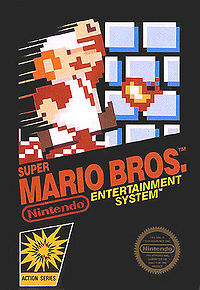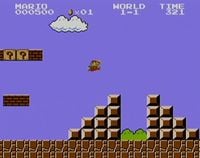Super Mario Bros.
- "SMB" redirects here. For the player from Massachusetts, see Smasher:SMB.
| Super Mario Bros. | |
|---|---|
 
| |
| Developer(s) | Nintendo EAD |
| Publisher(s) | Nintendo |
| Designer(s) | Shigeru Miyamoto |
| Released | |
| Genre(s) | Platformer |
| Platform(s) | Nintendo Entertainment System Family Computer Family Computer Disk System Game Boy Advance Virtual Console |
| Article on Super Mario Wiki | Super Mario Bros. |
Super Mario Bros. (スーパーマリオブラザーズ, Super Mario Bros.), sometimes referred to as Super Mario or SMB, is a 1985 platforming video game for the Nintendo Entertainment System. The plot is about a hero named Mario, who goes on a journey to save Princess Peach from the clutches of the evil Bowser, King of the Koopas, and restore peace to the land of the Mushroom Kingdom. Having sold immensely well, as it held the record for the world's best-selling video game for almost three decades, Super Mario Bros. is famous for saving the video game industry from the 1983 video game crash and popularizing the side-scrolling genre and it has been remade and ported on many Nintendo consoles. It appears as a Masterpiece in Super Smash Bros. Brawl and Super Smash Bros. for Wii U. In Brawl, it can be played for 60 seconds and starts at the first level. In Smash Wii U, it can be played for 180 seconds and starts at the title screen.
In the Super Smash Bros. series[edit]
Fighters[edit]
Peach, Bowser, and Piranha Plant debuted in this game. Mario and Luigi have costumes that make them look like they obtained a Fire Flower, an item that debuted in this game.
Moves[edit]
Mario, Luigi, and Dr. Mario's up special move, Super Jump Punch, is based on the jumping animation from this game, and starting from Brawl, the jump sound effect from this game plays during both their grounded and midair jumps. Mario and Luigi's neutral special move, Fireball, is based on the Fire Mario power up. Toad, a character that first appeared in this game, appears as Peach's neutral special move. Bowser's Fire Breath move is based on his ability to breathe fire. Even though he first showed this ability in Super Mario 64, he could spit fireballs since this game. Additionally, one of his custom moves, Fire Shot, is based on his ability to spit fireballs in this game. His up special move, Whirling Fortress, may be based on how Koopas enter their shells when hit.
Stages[edit]
Stages in Smash 64, Melee, and Brawl are based on this game. The first two stages look similar to how the original game looks and even have the original music playing. Mushroomy Kingdom has two versions: one is a recreation of World 1-1, and the other is a recreation of World 1-2. In addition, this game is the basis for one of the themes of the Super Mario Maker stage.
Items[edit]
Many items from this game, namely the Super Mushroom, the Fire Flower, the Super Star, and the Green and Red Shells made their first appearances in this game. The Super Mushroom can be found in blocks and makes Mario and Luigi grow bigger. The Fire Flower can also be found in blocks. It changed Mario and Luigi's clothes, giving them the power to throw fireballs. The Super Star is another item that can be found in blocks, and makes Mario and Luigi invincible, also giving them the power to defeat enemies just by touching them. Green and Red shells can be obtained by defeating Koopas and are used to defeat enemies.
Assist Trophies[edit]
Lakitu and Spinies and Hammer Bro are both enemies in this game. Both of them appear as assist trophies, and act the same way they do in this game. Lakitu and Spinies even retain their original 8-bit look.
Enemies[edit]
Lots of enemies from this game appear as enemies in Adventure Mode, Adventure Mode: The Subspace Emissary and Smash Run. These are Goombas, Koopa Troopas, Koopa Paratroopas, Bullet Bills, Bill Blasters, Hammer Bros., Lakitus, and Spinies.
Misc.[edit]
Mario's taunt (up taunt in Brawl and SSB4) in the first four Smash games references this game: he grows larger, then shrinks back to normal, all while standing in the same idle stance as he does in Super Mario Bros. SSB4 even uses SMB's power-up and power-down sounds for the taunt.
The game's name may have inspired the name of the English versions of the Smash Bros. games.
Interestingly enough, the exact date of Super Mario Bros's original American release is currently unknown; though several sources have made their estimates, there has been no credible evidence to verify them. The closest estimate comes from the Chronicle in Brawl, which pinpoints the release date at October of 1985.
The Japanese cover of the game appears as a sticker in Super Smash Bros. Brawl.
| Masterpieces in Super Smash Bros. Brawl | |
|---|---|
| Starter games | Ice Climber · Kid Icarus · Kirby's Adventure · Star Fox 64 · Super Mario Bros. · Super Metroid · The Legend of Zelda |
| Japan-only games | EarthBound · Fire Emblem: Mystery of the Emblem |
| Unlockable games | Donkey Kong · F-Zero · Super Mario Bros. 2 · Super Mario World · The Legend of Zelda · The Legend of Zelda: Ocarina of Time |
| Masterpieces in Super Smash Bros. for Wii U | |
|---|---|
| Starter games | Balloon Fight · Donkey Kong · F-Zero · Kid Icarus · Kirby Super Star · Kirby's Dream Land · Mega Man 2 · Metroid · Pac-Man · Pilotwings · Super Mario Bros. · Super Mario Bros.: The Lost Levels · Super Mario Kart · Super Mario World · Super Metroid · The Legend of Zelda · Wrecking Crew · Zelda II: The Adventure of Link |
| Unlockable games | Dr. Mario · EarthBound · Kirby's Adventure · Punch-Out!! Featuring Mr. Dream · Yoshi |
| Japan-only games | Fire Emblem: Shadow Dragon and the Blade of Light |
